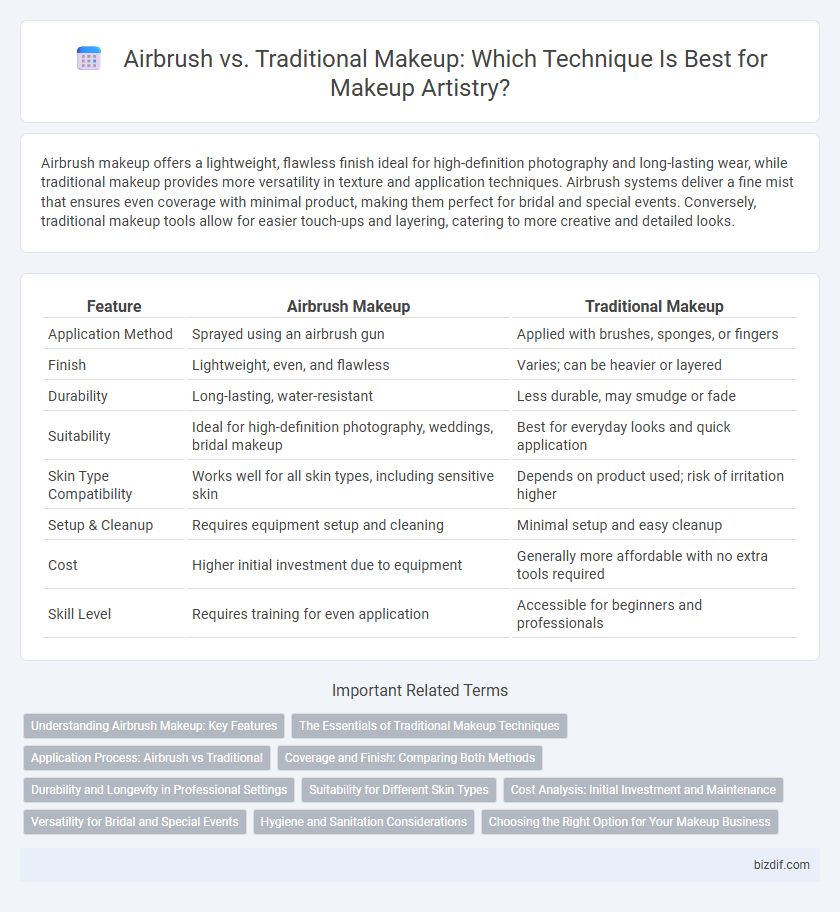Airbrush makeup offers a lightweight, flawless finish ideal for high-definition photography and long-lasting wear, while traditional makeup provides more versatility in texture and application techniques. Airbrush systems deliver a fine mist that ensures even coverage with minimal product, making them perfect for bridal and special events. Conversely, traditional makeup tools allow for easier touch-ups and layering, catering to more creative and detailed looks.
Table of Comparison
| Feature | Airbrush Makeup | Traditional Makeup |
|---|---|---|
| Application Method | Sprayed using an airbrush gun | Applied with brushes, sponges, or fingers |
| Finish | Lightweight, even, and flawless | Varies; can be heavier or layered |
| Durability | Long-lasting, water-resistant | Less durable, may smudge or fade |
| Suitability | Ideal for high-definition photography, weddings, bridal makeup | Best for everyday looks and quick application |
| Skin Type Compatibility | Works well for all skin types, including sensitive skin | Depends on product used; risk of irritation higher |
| Setup & Cleanup | Requires equipment setup and cleaning | Minimal setup and easy cleanup |
| Cost | Higher initial investment due to equipment | Generally more affordable with no extra tools required |
| Skill Level | Requires training for even application | Accessible for beginners and professionals |
Understanding Airbrush Makeup: Key Features
Airbrush makeup utilizes a fine mist application technique that offers a lightweight, flawless finish ideal for high-definition photography and long-lasting wear. Unlike traditional makeup, it provides precise coverage with less product waste and reduces the risk of caking or uneven texture. The technology behind airbrush systems allows for customizable layering, making it suitable for various skin types and complexions.
The Essentials of Traditional Makeup Techniques
Traditional makeup techniques prioritize precision through tools like brushes, sponges, and fingers to sculpt and define facial features with a hands-on approach. These essentials include layering foundations for buildable coverage, contouring for dimension, and blending eyeshadows seamlessly to create customized looks. Mastery of classic methods ensures adaptability across varied skin types and occasions, highlighting the artist's skill in color theory and texture manipulation.
Application Process: Airbrush vs Traditional
Airbrush makeup involves using a specialized compressor and gun to spray a fine mist of foundation, providing a lightweight, seamless finish that adheres evenly to the skin. Traditional makeup application relies on brushes, sponges, or fingers to layer products, allowing for more control but often requiring multiple touch-ups throughout the day. Airbrush techniques excel in creating a flawless, long-lasting look, especially for HD photography and special events, while traditional methods offer versatility for varied coverage and texture manipulation.
Coverage and Finish: Comparing Both Methods
Airbrush makeup provides a lightweight, flawless finish with buildable coverage that appears natural and radiant, ideal for high-definition photography and long-lasting wear. Traditional makeup offers more control over coverage intensity, allowing for easy touch-ups and customization, but may feel heavier and less uniform on the skin. Both techniques vary in application methods, where airbrush delivers a fine mist for seamless blending, while traditional makeup relies on brushes or sponges for layering pigment.
Durability and Longevity in Professional Settings
Airbrush makeup offers superior durability and longevity compared to traditional methods, making it ideal for long professional shoots and events. The fine mist application creates a lightweight, waterproof, and smudge-resistant finish that lasts up to 12-24 hours without touch-ups. Traditional makeup, while easier to apply and blend, often requires frequent reapplication due to oil and sweat breakdown, reducing its effectiveness in high-intensity professional settings.
Suitability for Different Skin Types
Airbrush makeup is ideal for oily or combination skin due to its lightweight, non-comedogenic formula that reduces the risk of clogged pores and shine. Traditional makeup offers better control and versatility for dry or mature skin, providing richer hydration and easier blending. Choosing the right technique depends on skin sensitivity, desired finish, and longevity requirements.
Cost Analysis: Initial Investment and Maintenance
Airbrush makeup systems typically require a higher initial investment, with prices ranging from $200 to $1,000 for compressors and airbrush kits, compared to traditional makeup tools that cost $20 to $100. Maintenance for airbrush equipment involves regular cleaning and occasional part replacements, which can add $50 to $150 annually, whereas traditional makeup maintenance primarily involves purchasing replacement brushes and products at lower costs. Over time, traditional makeup proves more affordable, but professional artists may justify the airbrush's upfront and upkeep costs due to its precision and durability.
Versatility for Bridal and Special Events
Airbrush makeup offers exceptional versatility for bridal and special events, providing a lightweight, long-lasting finish that resists sweat and humidity, making it ideal for all-day wear and photos. Traditional makeup techniques allow for more detailed, customizable application with diverse product textures and shades suited for touch-ups and dramatic looks. Both methods can be combined to enhance durability and achieve flawless, personalized results tailored to specific skin types and event requirements.
Hygiene and Sanitation Considerations
Airbrush makeup offers a more hygienic application by minimizing direct contact with the skin, reducing the risk of cross-contamination compared to traditional brushes and sponges that require frequent cleaning between uses. The closed system of airbrush machines ensures that makeup is sprayed evenly from the device, preventing the buildup of bacteria on applicators common in traditional methods. Proper sanitation protocols for airbrush equipment include regular sterilization of nozzle parts and air filters, promoting safer use for multiple clients in professional makeup artistry.
Choosing the Right Option for Your Makeup Business
Airbrush makeup offers a lightweight, flawless finish ideal for high-definition photography and long-lasting wear, making it a preferred choice for bridal and special-event clients. Traditional makeup techniques provide versatility with a wide variety of textures and finishes, suitable for creative and everyday looks that require precision and adaptability. Selecting the right option depends on your target market, service offerings, and equipment investment, balancing client needs with professional expertise in makeup artistry.
Airbrush vs Traditional Infographic

 bizdif.com
bizdif.com